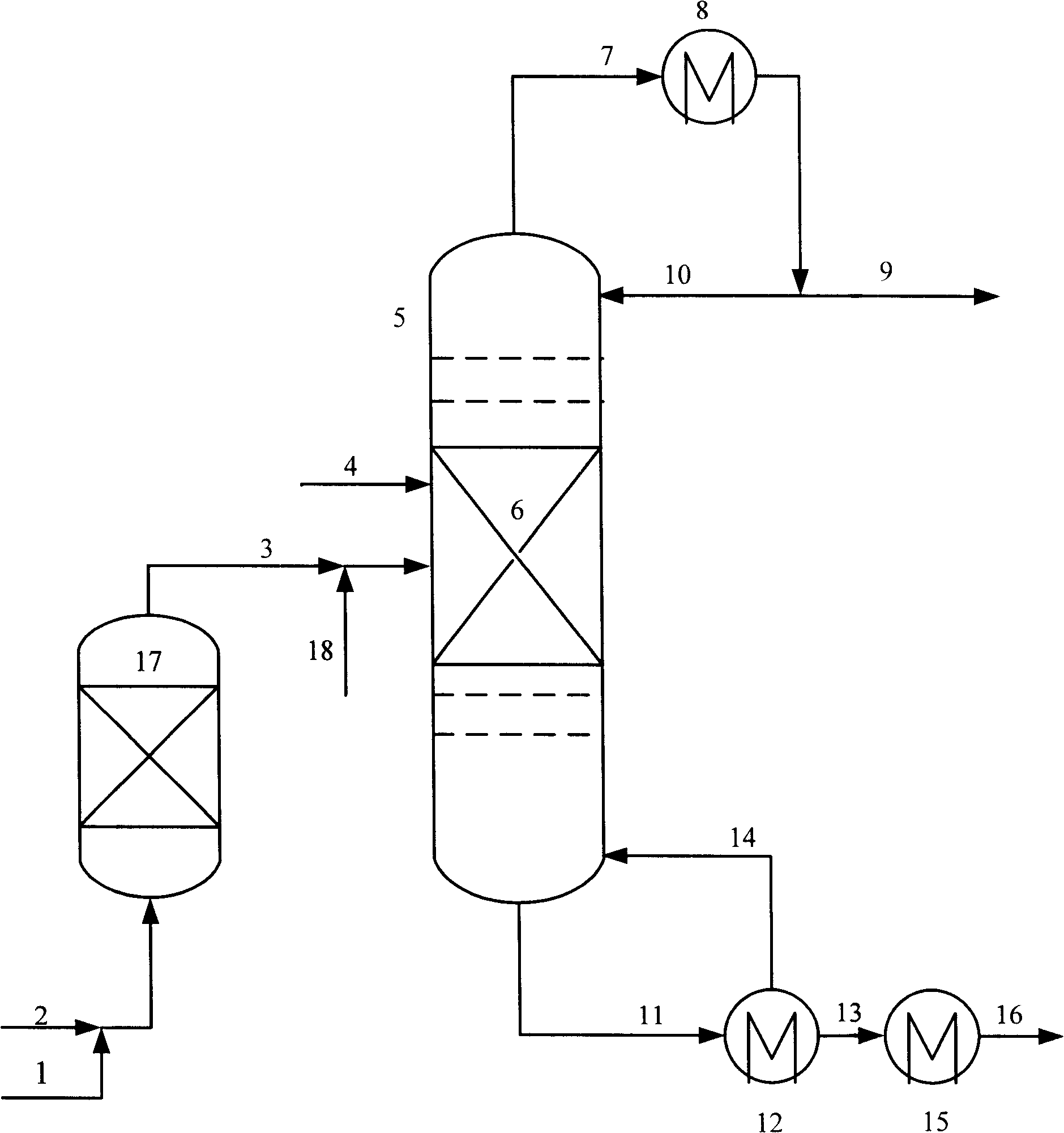Etherification method combined with catalytic cracking absorption stable system
An absorption stabilization system and catalytic cracking technology, applied in the treatment of hydrocarbon oil, petroleum industry, etc., can solve the problems of complex process and many process steps, and achieve the effect of increasing octane number, more operational flexibility, and reducing olefin content
- Summary
- Abstract
- Description
- Claims
- Application Information
AI Technical Summary
Problems solved by technology
Method used
Image
Examples
Embodiment 1
[0037] The hydrocarbon etherification raw material that present embodiment adopts is the C that contains 20% isobutene 4 Fraction, C 4 The distillate is contacted and reacted with catalyst A in the pre-etherification reactor, and the reaction conditions are that the reaction temperature is 130°C, the reaction pressure is 1.5MPa, and the weight space velocity of the feed liquid is 2.0h -1 , the reaction result is that the conversion rate of isobutene is ≤ 1%, the diene in the reaction product is ≤ 100 μg / g, and the content of alkali nitrogen is ≤ 1 μg / g.
[0038] The reaction product obtained above is mixed with methanol and then enters the stabilizing tower, where it contacts and reacts with catalyst A in the reaction section and undergoes fractional distillation. The gas component is obtained from the top of the stabilizing tower, and MTBE is obtained at the bottom of the stabilizing tower. The operating conditions are: alcohol / ene mass ratio is 0.5, tower top temperature is...
Embodiment 2
[0040] The hydrocarbon etherification raw material used in this embodiment is liquefied gas, and the content of isobutene in the liquefied gas is 15%. After the liquefied gas is mixed with methanol, it contacts and reacts with the catalytic cracking catalyst DOCP in the pre-etherification reactor. The reaction condition is alcohol / The hydrocarbon mass ratio is 0.3, the reaction temperature is 100°C, the reaction pressure is 1.7MPa, and the weight space velocity of the feed liquid is 6.0h -1 , the reaction result is based on olefins, olefin polymerization selectivity ≤ 0.5%, dienes in the reaction product ≤ 100 μg / g, alkali nitrogen content ≤ 1 μg / g.
[0041] The reaction product obtained above is mixed with methanol and then enters the stabilizing tower. In the reaction section, it contacts and reacts with the strong acid cation exchange resin Amberlyst35 and conducts fractionation. The gas component is obtained from the top of the stabilizing tower, and MTBE is obtained at th...
Embodiment 3
[0045] The hydrocarbon etherification raw material used in this example is the same catalytic cracking deethanized gasoline raw material 1 as in Comparative Example 1. After the catalytic cracked deethanized gasoline is mixed with methanol, it contacts with catalytic cracking catalyst CGP-1 in the pre-etherification reactor Reaction, the reaction conditions are that the alcohol / hydrocarbon mass ratio is 0.1, the reaction temperature is 120°C, the reaction pressure is 1.5MPa, and the weight space velocity of the feed liquid is 2.0h -1 , the reaction result is based on olefins, olefin polymerization selectivity ≤ 0.5%, dienes in the reaction product ≤ 100 μg / g, alkali nitrogen content ≤ 1 μg / g.
[0046] The reaction product obtained above is mixed with methanol and then enters the stabilizing tower. In the reaction section, it contacts and reacts with the etherification catalyst strong acidic cation exchange resin Amberlyst35 and conducts fractional distillation. The liquefied ga...
PUM
 Login to View More
Login to View More Abstract
Description
Claims
Application Information
 Login to View More
Login to View More - R&D
- Intellectual Property
- Life Sciences
- Materials
- Tech Scout
- Unparalleled Data Quality
- Higher Quality Content
- 60% Fewer Hallucinations
Browse by: Latest US Patents, China's latest patents, Technical Efficacy Thesaurus, Application Domain, Technology Topic, Popular Technical Reports.
© 2025 PatSnap. All rights reserved.Legal|Privacy policy|Modern Slavery Act Transparency Statement|Sitemap|About US| Contact US: help@patsnap.com


